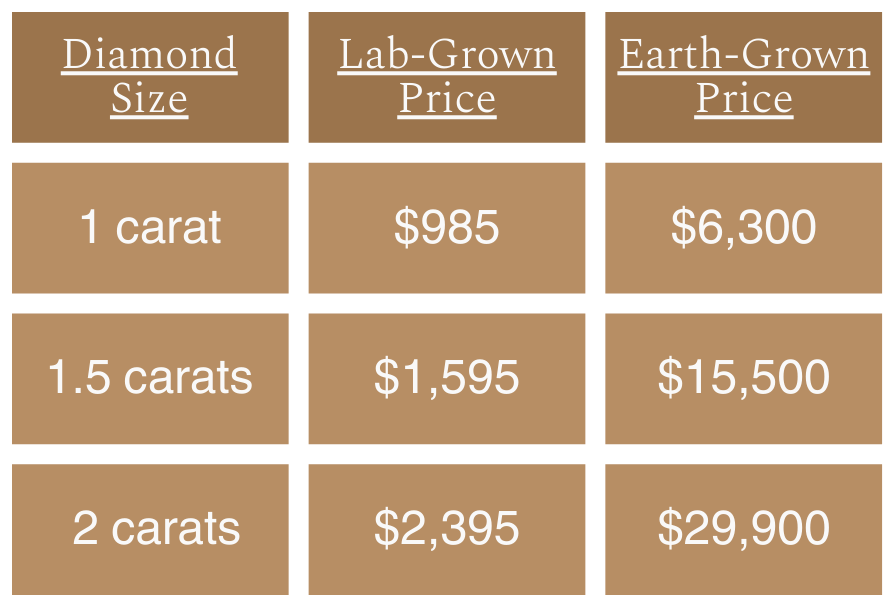29th Aug 2023
Unveiling the Truth Behind Natural vs. Lab-Grown Diamonds Prices
Lab-grown diamonds have taken the jewelry world by storm, and at Yates & Co, we couldn't be more excited to be a part of this revolutionary trend. There's no denying the remarkable surge in their popularity, and we're thrilled to share with you the inside scoop on their pricing dynamics, which often surprise customers who are expecting to pay much more.
“Over the past six months, an astounding 90% of engagement ring shoppers, folks aged from late 20s to 40s, come to us asking for lab-grown diamonds.” — Ron Yates
Natural Diamond Prices Can Feel Out of Reach
When it comes to natural diamonds, their pricing can sometimes feel like reaching for the stars. The four C's (color, clarity, cut grade, and carat) play a pivotal role in determining their value, and top-notch grading labs like the Gemological Institute of America (GIA) and International Gemological Institute (IGI) set the standard for assessing natural diamond quality.
It's hard not to feel "sticker shock" when shopping for natural diamonds, especially if you're new to jewelry. So why do earth-created diamonds come with such a hefty price tag?
Starting in the late 1800s through the start of the 21st century, DeBeers controlled more than 80% of rough diamond distribution, giving them power to manipulate prices. A genius marketing campaign with the well-known tagline "a diamond is forever" linked diamonds to love and cemented their status as highly-coveted treasures. Not only did DeBeers command pricing, but they also inspired demand!
Luxurious Yet Affordable: Lab-Grown Diamond Prices
Let's debunk the myth that lab-grown diamonds are "fake" or lesser alternatives. Quite the opposite, these diamonds are authentic, created using cutting-edge technology. What's even more remarkable is their pricing model, which is nothing short of revolutionary.
These gems offer several advantages over mined diamonds. They're cultivated from tiny crystals, bypassing the need for extensive mining, massive infrastructures, and controlled pricing monopolies. The result? Exquisite diamonds that don't break the bank but still sparkle with brilliance and quality.
Grown in a controlled lab setting, they tend to have fewer inclusions, making them super clear and visually stunning. Plus, you can get them in precise shapes and sizes, perfect for customizing unique jewelry. Natural diamonds with rare colors? Tough and pricey to find. But lab-grown diamonds? They offer a consistent supply of amazing colors, making it a breeze to get what you love!
It's clear that lab-grown diamonds offer a brilliant choice for both your style and your wallet. So why not embrace this modern marvel and make a dazzling statement without compromise?
Lab-Grown vs. Natural Diamond Price Comparison
Among the dazzling array of lab-grown diamond options, one classic size in particular has been stealing the spotlight and winning hearts - the fabulous 1-carat wonder!
It's a perfect blend of value and beauty, wrapped up in an elegant size that's simply irresistible, especially when it comes to engagement rings. These 1-carat lab-grown diamonds come with competitive price tags that'll leave you pleasantly surprised. Talk about affordable luxury!
If you're on the lookout for that ideal balance of brilliance and budget-friendliness, look no further than these stunning 1-carat lab-grown diamonds. See the chart below for price comparisons between lab-grown diamonds and their earth-created counterparts:

Carat weight plays a major role in determining the price of these stunning gems. With lab-grown diamonds, you've got a golden opportunity to go big with the carat weight without putting a dent in your finances. It's all about adding that extra sparkle without the stress!
“We determine our lab-grown diamond prices based on our costs and try to keep them at a very competitive price.” — Ron Yates
There's an allure of getting a larger, higher-quality diamond for a fraction of what a mined diamond would cost. And get this - the larger the diamond, the more dramatic the savings are.
High Quality Lab-Grown Diamond Prices Are Affordable Now!
Your lab-grown diamond should have a minimum quality of F color, VS2 clarity, and Ideal cut grade. This is what we suggest to our customers, and we only stock this quality or higher. All our 1ct sized and larger are graded and certified by the renowned diamond lab IGI (International Gemological Institute) to ensure this high quality.
For decades, many jewelers would sell low quality mined diamonds (J-K-L color and lower, I1 clarity, poorly cut) to their customers to offer them an affordable diamond. But now with the lab-grown option, there's no need to settle for an ugly diamond!
Sure, there are low quality lab-grown diamonds out there, but the price difference doesn’t make it worthwhile for the consumer now. A top-end lab diamond doesn't cost much more than an ugly one. So we're very picky about the diamond quality. It’s not worth the trade off of a few dollars for a less than stunning top quality diamond.
"No one will know whether her brand new earrings or bracelet are lab-grown or earth-created. Only you will know. But your bank account will thank you." - Ron Yates
FAQs About Lab-Grown Diamond Pricing
Since lab-grown diamonds are fairly new to the marketplace, our customers often come to us with many questions. These are some answers to the most frequently-asked ones.
Why are lab-grown diamonds so much cheaper?
A few reasons. First, they can be grown in a matter of a few weeks, then cut, faceted, and polished. There isn't the huge cost of deep earth mining with the tens of millions of dollars of equipment needed. Second, the lab-grown diamond market is not controlled by the DeBeers syndicate. So prices are dictated by true supply and demand. They're not artificially manipulated.
Will my fiancé-to-be feel upset if I buy them a less-expensive diamond?
It's important to begin with a clear and direct answer: no, the price of a diamond doesn't quantify your love. Love is an emotion that can't be measured in carats or dollars.
The diamond industry has skillfully crafted a narrative that bigger, more expensive diamonds signify a greater depth of love. It's a compelling story, but remember, it's a marketing tactic and not a reflection of truth. It’s also worth remembering that this narrative is relatively recent, only becoming widespread during the 20th century.
Choosing an engagement ring, including the center stone, is more about personal preference, shared values, and financial circumstances. It should be a symbol of commitment, not a measure of your bank balance or a yardstick of your love.
An increasing number of couples are becoming aware of this and are turning to lab-grown diamonds. The shift towards lab-grown diamonds indicates a broader change in societal values, with an emphasis on conscious consumption, sustainable practices, and financial prudence.
In a nutshell, the right engagement ring for your fiancé-to-be is the one that fits their style, aligns with their (and your) values, and respects your shared financial goals. After all, love is not about material possessions, but about understanding, respect, shared dreams, and a lifelong commitment to each other.
Do I really need to spend a month's salary on the engagement ring?
One of the most persistent myths surrounding engagement rings is the notion that one should spend at least a month's salary on the ring (again a DeBeer's marketing tactic). In response to the frequently asked question, "Do I really need to spend a month's salary on the engagement ring?" It's important to know this is not a hard and fast rule.
Don't let old school rules and marketing tactics dictate how much you should spend on an engagement ring. Instead, communicate openly with your partner, and make a choice that's right for both of you.
Do lab-grown diamonds have resale value?
The answer is, yes, but with some qualifications. Like most goods, both lab-grown and natural diamonds depreciate after purchase. It's also important to note that the secondary market for diamonds, in general, isn't as robust as, say, gold or other precious metals.
Regardless of whether a diamond is lab-grown or mined, selling it used will likely yield a lower price than you originally paid.
However, the resale value of lab-grown diamonds tends to be lower than natural diamonds. This is mainly because natural diamonds, especially rare and high-quality ones, have a unique appeal due to their natural origin and perceived scarcity. They also have a longer-established market, which influences their resale value.
Lab-grown diamonds, being relatively new entrants to the market, don't have this lengthy history or the same level of consumer demand in the secondary market. But as the market for lab-grown diamonds continues to grow, and they become more accepted and mainstream, it's possible that their resale value may increase over time.
Getting the Best Lab-Grown Diamonds Is An Investment Worth Cherishing
To ensure you get the best lab-grown diamond piece, we encourage you to share your dream jewelry design with us. Our passion lies in crafting custom pieces tailored to your unique preferences, ensuring you find the perfect lab-grown diamond that will stand the test of time and cherish your memories forever.
Remember, the beauty of lab-grown diamonds lies in their indistinguishable brilliance from natural diamonds. Your secret is safe with us; your bank account will thank you.
Plus, if you've been dreaming of a particular jewelry design, don't hesitate to share it with us! Our expertise lies in creating stunning custom pieces using lab-grown diamonds, giving you exceptional value without compromising elegance.
Step into the world of lab-grown diamonds at Yates & Co, and let your timeless investment shine. Visit this page for more information.






